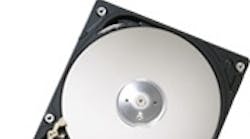The trend toward the greening of IT will continue to be a driving force behind IT product development efforts as PC and server OEMs build products to comply with global energy-rating programs. Every component within these systems must also be specified to contribute to reductions in overall power consumption.
With this in mind, Hitachi Global Storage Technologies' (GST) desktop hard disk drives (HDDs) have incorporated Advanced Power Management capabilities to reduce power consumption.
According to Hitachi, its Deskstar P7K500 hard drive provides customers with up to a 40 percent improvement over previous-generation products by reducing power in both idle and active modes. This reduction was achieved by using system-on-chip (SOC) technology adapted from Hitachi's 2.5-inch mobile product line, where low power has long been a key design attribute to maximize battery life in notebook PCs. This SOC incorporates Hitachi Voltage Efficiency Regulator Technology in which switching regulators are used in place of the less-power-efficient linear regulators in the voltage reduction processes.
Also included in the SOC is a more power-efficient module for the SATA and PATA interfaces. Together with the new technologies incorporated into the Deskstar P7K500 HDD, Hitachi GST's Advanced Power Management capabilities have reduced the overall power consumption of the HDD to industry-leading levels. Through the use of Hitachi GST's patented load/unload technology, the Deskstar P7K500 HDD allows for additional power reductions:
When Advanced Power Management is enabled, the hard drive can automatically enter the lower-power idle states, described above, at intervals based on the time since the host system last accessed the hard drive. The drive can transition from normal idle (3.6W power) to unload idle (3.2W) to low RPM idle (2.0W) during periods of inactivity and return to normal operation automatically whenever the host system accesses it again. These transitions to lower-power idle states are done without intervention from the host system.
For more information, visit www.hitachigst.com.
Interested in information related to this topic? Subscribe to our Information Technology eNewsletter.



